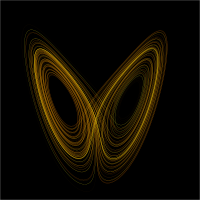
Photo from wikipedia
We study a system of N identical interacting particles moving on the unit sphere in d-dimensional space. The particles are self-propelled and coupled all to all, and their motion is… Click to show full abstract
We study a system of N identical interacting particles moving on the unit sphere in d-dimensional space. The particles are self-propelled and coupled all to all, and their motion is heavily overdamped. For d=2, the system reduces to the classic Kuramoto model of coupled oscillators; for d=3, it has been proposed to describe the orientation dynamics of swarms of drones or other entities moving about in three-dimensional space. Here, we use group theory to explain the recent discovery that the model shows low-dimensional dynamics for all N≥3 and to clarify why it admits the analog of the Ott-Antonsen ansatz in the continuum limit N→∞. The underlying reason is that the system is intimately connected to the natural hyperbolic geometry on the unit ball Bd. In this geometry, the isometries form a Lie group consisting of higher-dimensional generalizations of the Möbius transformations used in complex analysis. Once these connections are realized, the reduced dynamics and the generalized Ott-Antonsen ansatz follow immediately. This framework also reveals the seamless connection between the finite and infinite- N cases. Finally, we show that special forms of coupling yield gradient dynamics with respect to the hyperbolic metric and use that fact to obtain global stability results about convergence to the synchronized state.
Journal Title: Chaos
Year Published: 2021
Link to full text (if available)
Share on Social Media: Sign Up to like & get
recommendations!